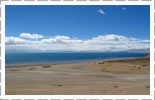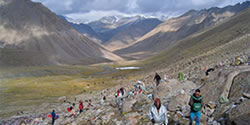|
Lhasa (The Land of Gods)
Lhasa is the capital of Tibet. Bordered by the north bank of the Kyichu River, Lhasa is located at an altitude of 3650m above sea level. Its 1300-year old history has put it at the center of politics, economy, culture and religion in Tibet since ancient times. There are numerous scenic spots and famous historical attractions among which are Potala Palace, Norbulingka, Drepung Monastery, Sera Monastery, Ramoche Monastery, Jokhang Temple and Barkhor Street Market.
Shigatse (The Estate that Fulfills Ones’ Wishes)
Shigatse is Tibet’s second biggest city and it is the center of transportation and a distribution center for agriculture and husbandry products into the southeast. Monasteries such as Tashilunpo and Shalu are its major historic attractions.
Tsedang
Tsedang, the third largest town in Central Tibet, 196 km from Lhasa, is known as the cradle of Tibetan civilization. The ancient town offers a number of side trips that illustrate Tibet’s early history. It was the ancient capital of the Yarlung Kings who established the Tibetan nation. The Yumbulagang Palace (built by the first Yarlung King) and the Tandruk Monastery (one of the three royal Buddhist temples) are some of the major sites.
Yamdrok Yumtso (The Sacred Lake)
One of the three largest lakes in Tibet, Yamdrok Yumtso lies about a hundred kilometers southwest of Lhasa. The surface of the lake covers some 600 sq. km. Interior hills form islands that provide homes to flock of wild ducks. Fish are plentiful and has been a supply for the diet of the locals.
Ganden Monastery
Founded in 1409 by Tsong Khapa, the founder of the Gelugpa (Yellow Hat Sect), this monastery is the earliest of the three great monasteries of Tibet. It lies 70 km east from Lhasa, situated at 4300m on a hidden side of mountain top commanding a spectacular view of the Lhasa river valley.
Jokhang Temple
It is a 4-storied temple of golden splendor featuring architecture of the Tang Dynasty from the 7th century AD. Murals and historical relics depict famous figures and stories from the past.
The Karo Ruins
These four to five thousand year old ruins include house architecture, stone paved roads, stone built walls, cave dwellings, and many different kinds of chipped stone implements. Their discovery provides new threads for the study of migration and exchange between people of the Neolithic Age.
Mt. Kailash
Mt. Kailash lies in the south-western part of the Tibet Autonomous Region of China. At 6714m, Mt. Kailash is the highest peak in the Kailash Range of the Himalayas. It is separated from the Great Himalayas chain by a trough that is drained in the north-west by the Sutlej River and in the south-east by the Yarlung Zangbo River. Mt. Kailash, which has religious significance for both Hindus and Tibetan Buddhists, is an important pilgrimage site.
Mansarovar Lake
The great Lake Mansarovar is situated in the south-west corner of Tibet and in the north-west of Nepal. It is beyond high Himalayas which borders Nepal and China. Tibetan plateau in itself is unique in its geographic make-up with its fauna and flora and mythical set-up of ecosystem. The lake is 20 km from Mt. Kailash and is one of the most beautiful and sacred lakes in Asia. It can be circumambulated in 4/5 days and looks like a gem of cobalt blue color. But during storm, it can turn into a churning black sometimes.
 |
|
|
Festivals in Tibet:
Festivals constitute an integral part of the life of Tibetan people who fundamentally observe to mark an event of their society recognized as a form of honour and respect to a person or super human phenomenon. There are countless festivals held over Tibet annually and every single festival has its own charm and joys to offer. In Tibet, there are rich varieties of festivals celebrating with great honour and significance. The dates of even the same festivals vary from region to region.
• Gutor (Day before New Year's Eve)
• Lhosar (1st-3rd day of the 1st lunar month)
• Monam (4th-11th of the 1st lunar month)
• Chunga Choepa (15th day of the 1st lunar month)
• Saka Dank Festival (15th day of the 4th lunar month)
• Horse Racing Festival (18th day of the 4th lunar month)
• Birthday of the 14th Dalai Lama (July 6 western calendar)
• Zamling Chisang (15th day of the lunar month)
• Guru Tsechu (10th day of the 6th lunar month)
• Bathing Festival (27th of the 7th lunar month)
• Horse Racing Festival (30th day of 7th lunar month)
• Butter Lamp Festival (25th day of the 10th lunar month)
|